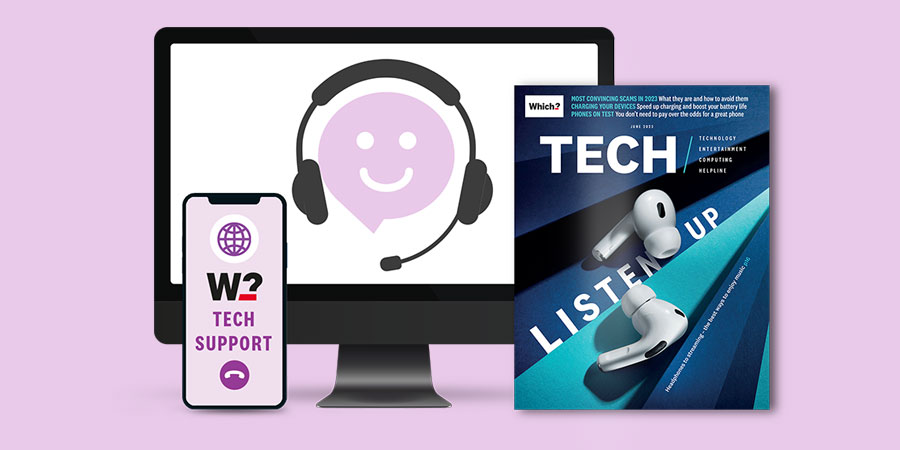
By clicking a retailer link you consent to third party cookies that track your onward journey. If you make a purchase, Which? will receive an affiliate commission which supports our mission to be the UK's consumer champion.
How to upgrade to Windows 10 for free

From checking whether your PC meets the Windows 10 requirements to managing your files and programs, our guide makes it simple to upgrade.
Do be aware that support for Windows 10 ends 14 October 2025. Ideally, you need to upgrade to Windows 11. However, if you're running a version of Windows that's older than 10, it's quite likely your PC doesn't meet the necessary specs - you can use our free Windows 11 requirement tool to check.

Keep reading to find out how to upgrade to Windows 10 for free.
Tech Support – stay on top of your tech and get unlimited expert 1-2-1 support by phone, email, remote fix and in print
Upgrading to Windows 10: what to do first
There are multiple versions of this OS. So first, establish which version of Windows 10 is right for you.
For the best chance of getting a free upgrade, your current version of Windows must be legal and activated with Microsoft.
Check this using Control Panel from the Start Menu, clicking on System and Security, and then System. At the bottom, it will say if the licence is activated. If you're using Windows 7, you’ll need to be on Windows 7 Service Pack 1 – if your PC is up to date, this should already be the case.
You can only upgrade if your PC has the necessary specs to run Windows 10. Check your PC exceeds the minimum requirements on Microsoft's website.

Back up
Before you start upgrading to Windows 10, you need to back up your data to protect it.
Also, make a note of any software product keys you have, such as for Microsoft Office. This is because you may need to reinstall it.
Agree to the terms and conditions
You now need to get the Windows 10 Media Creation Tool. Head to the Windows 10 download page and select Download Now.
Once the file’s downloaded, open it and agree to the various terms and conditions that are required. Select Upgrade this PC now when given the choice. If you don’t have enough space on your hard disk, you might need to free up space and run the installation from a USB stick.

Keep files or start anew?
You'll be given the choice to keep your files and programs, or start afresh with none of your programs and files.
The latter option is better for starting with a clean operating system, and if you backed up your files, you’ll be able to move the files and programs you need back onto your computer as and when you need them.
But keeping everything is arguably simpler and avoids you running into possible issues if you’ve lost the licence keys for some of the software you’re running on Windows 7 or 8.

Final steps
Sit back and let the upgrade happen. This could take a few hours depending on the speed of your PC and internet connection.
Your PC will restart itself a few times, but eventually you’ll see the welcome screen for Windows 10.
You’ll need to make choices about some privacy arrangements and sign in to your Microsoft account if you have one. Then search for ‘activation’ in the Start Menu and click on it to see whether your Windows 10 licence is activated. If your Windows isn’t activated, you’ll need to buy a licence from a reputable third party.

What if my laptop or PC is too old for Windows 10?
If your laptop or PC doesn't meet Windows 10 requirements, you might want to consider buying a new one. We've tried and tested hundreds of laptops and PCs - see our pick of the best laptops and best desktop PCs to find one that suits you.
Alternatively, you can turn your old laptop into a free Chromebook with help from our handy guide.
Frequently asked questions
Why did Microsoft stop support for Windows 7, 8, and 8.1?
After launching new versions of Windows, Microsoft runs a period of ‘extended support’, bringing both feature updates and vital security protections against malware.
You typically get more than 10 years of support for Windows editions, but with cyber criminals so keen to target Windows users, when support ends it’s important to move on.
Do I have to buy a new computer?
Potentially, yes. Your existing model might not have the right specs for Windows 10. You can use Microsoft's compatibility checker to find out.
A computer that's still running Windows 7 will likely have ageing hardware and might struggle to perform with Windows 10, so buying a new model now will save you a hassle in the long run.
We've got lots of advice to help you find one that suits your budget. Don't miss our laptop deals, or our guide to buying a second-hand or refurbished laptop.
What about moving files and programs?
The most important thing to do before upgrading your system – and generally, in fact – is to back up your data.
You might need to reinstall some programs after you upgrade your system, so make a note of your product keys for software such as Office.
Will my printer and other devices work if I move to Windows 10?
This depends on the age of your printer, scanner or other devices.
The manufacturers try to keep the drivers up to date with the latest version of Windows, but any change can result in older kit no longer working.
Check your manufacturer’s website to see if there’s any information available before updating your system.

What alternative do I have to Windows?
You could opt for an Apple Mac. There's good reason why so many Apple fans find it hard to divert from the brand. The MacOS is known to be slick, fast and easy to use, and Apple puts lots of thought and money into the look and feel of these devices.
But they can be pricey - the newest Apple MacBook Pro 16-inch (2023) is the most expensive laptop we've reviewed at £2,639, and the 14-inch version isn't far behind. Even the cheapest MacBook will set you back at least £1,000 if you buy directly from Apple.
You might want to consider a Chromebook instead. These laptops run a more stripped back and simplified OS than Windows, but it runs well on cheap machines. The cheapest Chromebook we've reviewed (the Asus CX1400CNA) is just £150, while the most expensive from our testing (the Asus Flip CX5 Chromebook) typically costs around £600. Almost all models are designed to be thin and light with great battery life, so they're a good option for students or if you regularly travel or commute.
However, the simplicity of a Chromebook means you'll be mostly confined to web-based software alternatives for applications such as photo editors and other built-in apps. Chromebooks are best when connected to the internet, so if you don't have a connection, they're largely useless. You'll also need a Google account to set up everything properly.
Need help choosing? our Which? Tech Support team can point you to the right model for your needs with expert buying advice for subscribers.
Chromebook vs MacBook vs Windows laptop: we put these brands head to head to help you pick
Join Which? Tech Support
Which? Tech Support can help you keep you on top of your tech. Our experts explain things clearly so that you can resolve issues and feel more confident using your devices.
Get unlimited 1-2-1 expert support:
- by phone – clear guidance on choosing, setting up, using and resolving issues with your home tech devices
- by email – outline the issue and we’ll email you our answer
- by remote fix – we connect securely from our office to your home computer and resolve issues while you watch
- in print – Which? Tech magazine, six issues a year delivered to your door.
You can join Which? Tech Support for £4.99 a month or £49 a year.




















